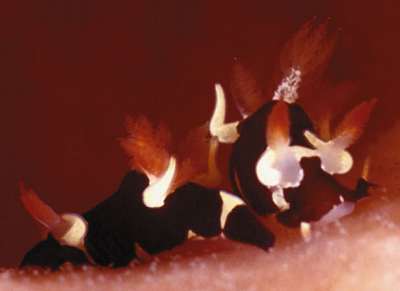
Trapania safracornia
Fahey, 2004
Order: NUDIBRANCHIA
Suborder: DORIDINA
Superfamily: ANADORIDOIDEA
Family: Goniodorididae
DISTRIBUTION
This species has been found only in Western Australia.
PHOTO
28 meters on the north side of Rottnest Island, off Perth, Western Australia. 7-8 mm long. Photo: Graeme Gunness
This species can be distinguished from other species of Trapania by the external red-brown coloration without any overlying white spots. In addition, there are symmetrical white patches between the red-brown color that is overlaid with yellow pigment. Trapania safracornia can also be distinguished by a yellow-tipped tail and lateral processes and translucent red rhinophore clubs. The gill branches are translucent white with pinkish-tan apices. The radula morphology also differs from the externally most similar species, T. brunnea Rudman, 1987 found from the east and south coasts of Australia. The specimens examined from 28 meters on the north side of Rottnest Island, Western Australia, were 7-8 mm in length.
- Fahey, S. J. (2004) A new species of Trapania (Nudibranchia: Goniodorididae) from Western Australia with comparisons to other Indo-West Pacific Trapania. Zootaxa, 514: 1-12.
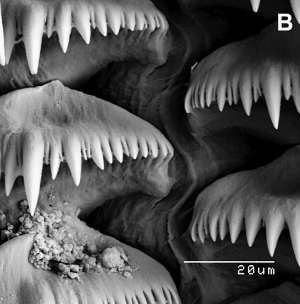
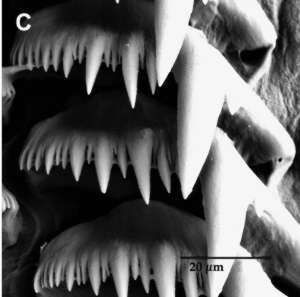
Fahey, S.J., 2005 (June 3) Trapania safracornia Fahey, 2004. [In] Sea Slug Forum. Australian Museum, Sydney. Available from http://www.seaslugforum.net/find/trapsafr
Related messages
Trapania safracornia from Fremantle WA
January 24, 2007
From: Brent Murdoch
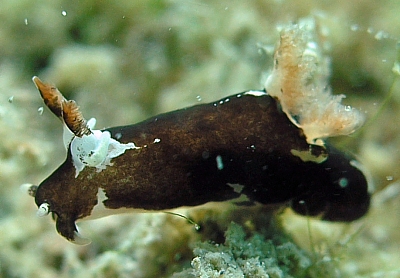
Hi Bill,
I was hoping that you could identify the attached. I have never seen them before. I watched 3 of them on a yellow sponge. They were quite small from 7 to 12 mm. They are in 4.5m of 23°C water close to Fremantle, Western Australia.
Brent Murdoch
bmurdoch@whimcreek.straits.com.au
Murdoch, B., 2007 (Jan 24) Trapania safracornia from Fremantle WA. [Message in] Sea Slug Forum. Australian Museum, Sydney. Available from http://www.seaslugforum.net/find/19304Dear Brent,
I am pretty sure this is Trapania safracornia, a species we know very little about. Certainly the general colour pattern, including the rhinophores, is very similar. Species of Trapania should have a pair of recurved papillae flanking the rhinophore stalks and the gills. I can see the rhinophore ones in your photo but am not sure I can see the ones alongside the gills. If you have a photo from another angle you might be able to confirm that they are there. Species of Trapania are often found on sponges, but don't eat them.
Best wishes,
Bill Rudman
Trapania safracornia? on eggs
August 26, 2006
From: Tom Davis
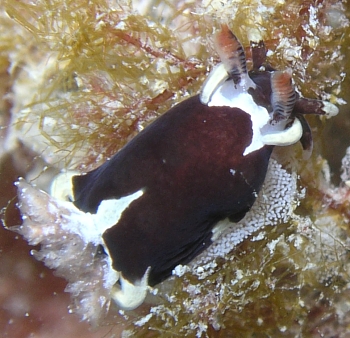
Concerning message #16740:
Bill
On 16 June we spotted another Trapania brunnea on what looks like eggs. Is this correct?
Locality: Ammunition Jetty, Coogee, 4m, Western Australia, Australia, Indian Ocean, 16 June 2006, Silty bottom with red algae. Length: 1 cm. Photographer: Tom Davis.
Thanks
Tom Davis
tom.davis@worleyparsons.com
Davis, T.R., 2006 (Aug 26) Trapania safracornia? on eggs. [Message in] Sea Slug Forum. Australian Museum, Sydney. Available from http://www.seaslugforum.net/find/17405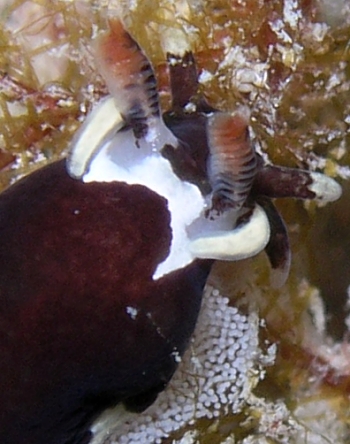
Dear Tom,
The eggs almost certainly belong to the Trapania. Looking at this animal, the very reddish tinge on the upper half of the rhinophores are much more like the red rhinophores described for T. safracornia. In your earlier message the animal showed no sign of the red.
There doesn't seem to be any sign of red on the gills, but the lateral processes are similar in colour to T. safracornia so I think I will reassess my earlier identification and call these animals T. safracornia. As I said earlier, it is possible this species is just a colour form of T. brunnea but we need to know much more about colour variability in both species, and also the group I am calling Trapania cf. brunnea.
Best wishes,
Bill Rudman
Trapania brunnea? in Perth, West Australia
June 14, 2006
From: Tom Davis
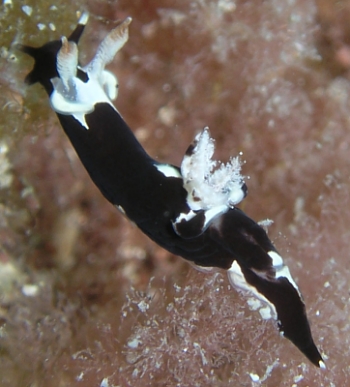
Hi Bill
On 21 May 2006 we spotted a small (1 cm) black and white nudibranch which we have not seen before in Perth. I have not managed to identify it using Sea Slugs of Western Australia and was hoping that you could help. The nudibranch bears a striking resemblance to Trapania brunnea. Is this the correct identification?
Locality: Ammunition Jetty, Coogee, Perth, 6 m, West Australia, Indian Ocean, 21 May 2006, Observed on algae under jetty. Length: 1 cm. Photographer: Tom Davis.
Thanks
Tom and Nicola Davis
tom.davis@worleyparsons.com
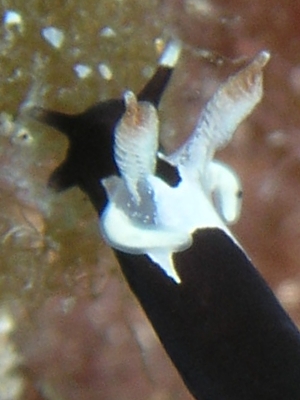
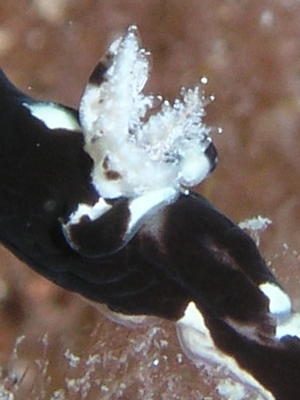
Note added 25 August 2006: Following message #17405 , I have reidentified this as Trapania safracornia... Bill Rudman
Dear Tom,
When I first saw your photo my first thought was Trapania safracornia a recently named species from Rottnest Island, off Perth. However on reflection I think it is T. brunnea. The main colour difference between your animal and 'typical' T. brunnea is that the lateral processes alongside the rhinophores are completely white whereas in T. brunnea they uasually have a large brown region midway. It definitely has similarities to T. safracornia, in which the lateral processes, beside the gills and beside the rhinophores are completely white. In the original illustration of T. safracornia [see Fact Sheet] both the gills and rhinophores are suffused with red, but it is possible that a fault in the photograph - perhaps from the red background. Unfortunately we only know of T. safracornia from the original description so we have no idea of its variability. It is of course possible that it is a western Australian colour variant of T. brunnea. Shireen Fahey mentions a difference in radular morphology between the two species but in general shape the two are very similar and the differences in denticulation found in specimens of T. brunnea from New South Wales and Victoria (Rudman, 1987) are no greater than found when comparing T. brunnea with T. safracornia.
I guess what we need, as a first step, are some more photos of T. safracornia from Rottnest Island and other parts of southwestern Australia so we have some idea of its colour variation
Best wishes,
Bill Rudman
Feeding in Trapania safracornia
June 4, 2005
From: Bill Rudman
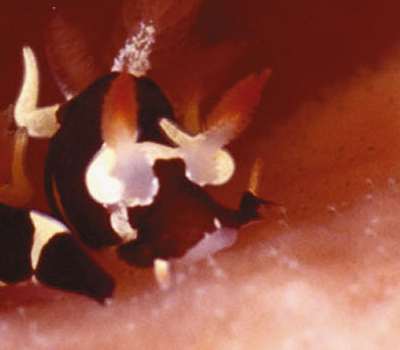
While preparing Graeme Gunness's photos for Shireen Fahey's Fact Sheet on Trapania safracornia Fahey, 2004, I noticed little stalked objects scattered all over the sponge on which the Trapania were sitting and apparently grazing [see close-up photo]. I am pretty sure these objects are stalked Entoprocts [Kamptozoa] which seem to be the staple food of many species of Trapania as was well illustrated by Bernard Picton in an earlier message [#3767].
Bill Rudman
billr@seaslugforum.net
Rudman, W.B., 2005 (Jun 4) Feeding in Trapania safracornia. [Message in] Sea Slug Forum. Australian Museum, Sydney. Available from http://www.seaslugforum.net/find/13950Trapania safracornia
June 4, 2005
From: Shireen Fahey
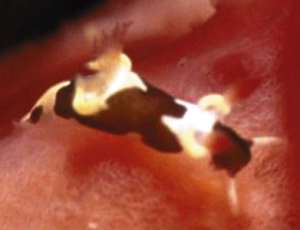
Dear Bill,
I have prepared some a Fact Sheet on Trapania safracornia Fahey, 2004. Here is another photo showing the symmetry of the colour pattern.
Locality: 28 meters on the north side of Rottnest Island, off Perth, Western Australia. 7-8 mm long. Photo: Graeme Gunness
-
Fahey, S. J. (2004) A new species of Trapania (Nudibranchia: Goniodorididae) from Western Australia with comparisons to other Indo-West Pacific Trapania. Zootaxa, 514: 1-12.
Best wishes,
Shireen
sfahey@calacademy.org
Fahey, S. J, 2005 (Jun 4) Trapania safracornia. [Message in] Sea Slug Forum. Australian Museum, Sydney. Available from http://www.seaslugforum.net/find/13957Thanks Shireen,
Best wishes,
Bill Rudman
